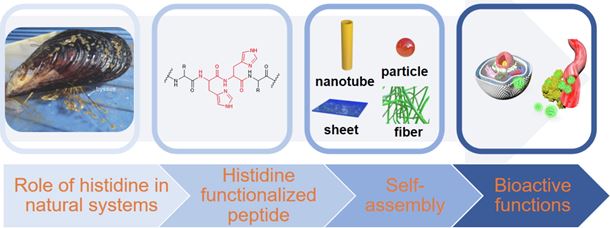Histidine as a key modulator of molecular self-assembly: Peptide-based supramolecular materials inspired by biological systems

Abstract
Histidine, a versatile proteinogenic amino acid, plays a broad range of roles in all living organisms and behaves as a key mediator of the interactions of biomolecules with inorganic constituents. The self-assembly of histidine-rich peptides and proteins is critical in biology, as the histidine unit is both a multifunctional regulator and an ideal motif for the construction of complex biological structures. In particular, non-covalent interactions between the imidazole ring and other molecular building blocks and metal ions are routinely employed to generate these complexes. Therefore, this strategy can be duplicated in an artificial context to create sophisticated bioactive materials. In this review, we first highlight a clear perspective of the bio-inspired design strategies which can replicate the hierarchical structure of biological systems allowing the engineering of the supramolecular self-assembly of histidine-functionalized peptides. We further summarize advancements in the field of peptide supramolecular structures incorporating histidine residues in the peptide backbone to generate organized functional supramolecular biomaterials with customizable features. We also discuss significant advances and future prospects in supramolecular self-assembly of histidine-functionalized peptides, as well as provide an overview of advanced techniques for the fabrication of histidine-based biomaterials for bio-nanotechnology, optoelectronic engineering, and biomedicine. Overall, artificial supramolecular materials based on histidine functionalized peptides, motivated by the intriguing properties discovered in natural proteins, bear the potential to boost the creation of sustainable bio-inspired materials.

See full text for more information.



